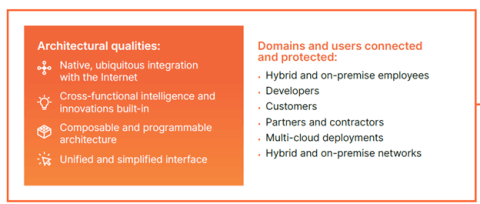
Bashar Bashaireh, Managing Director & Head of Middle East and Türkiye at Cloudflare, discusses the need for a different type of cloud—one that delivers secure, performant, any-to-any connectivity.
Historically IT operations and security teams focused mostly on managing their organisation’s on-prem environment. But as business requirements changed, customer bases became global, and remote work took root, these technology teams were handed responsibility across more domains: cloud deployments, SaaS applications, and the public Internet. Individually, each domain has more than its fair share of complex management and security considerations.
It’s no surprise that technology teams have less and less control as they try to combine these disparate domains into something like a single environment to meet business needs. Many organisations have proven to be adept at introducing new technologies, but not so focused on managing older technologies out of their environments. This greatly complicates crucial tasks like managing employee access, gaining full visibility into what they have in production, setting global security policies, and monitoring and improving network performance. And it’s hard to find an organisation where such loss of control hasn’t become a problem. According to a recent Cloudflare survey conducted by Forrester Research, 99% of businesses say they require secure, performant, “any-to-any” connectivity more than ever before.
New research shows the broader effects of this “control gap” on the business as a whole, through lost speed and productivity, increased risk, and greater costs.
Speed and productivity – Loss of control slows organisations down. Technology teams spend more time testing and securing complex systems. Technical debt and convoluted infrastructure requirements pile up. Delivery dates for new applications are delayed, leading to an inability to reach new customers or markets before competitors do — giving nimbler startups a chance to win the disruptive innovation game.
Risk – Loss of control amplifies risk in the areas of cybersecurity, legal and policy compliance, and operational stability. Such risk may accumulate slowly, but the consequences often strike suddenly and publicly: devastating ransomware, stolen data offered for sale publicly, or paralyzing logistical slowdowns.
Cost – Loss of control imposes a heavy opportunity cost: the inability of technology teams to focus on efforts that add value to the business. Cost is also driven by the need to hire more people — and buy more tools — to bring some measure of order to complex technology environments.
The Connectivity Cloud: A New Way to Connect, Protect, and Accelerate Business
Organisations won’t fix the control gap in their IT environment with isolated optimisations and more point products. A new approach is needed. They need a different type of cloud—one that delivers secure, performant, any-to-any connectivity. It has to integrate with all networks, give full programmability to support any use case, and deliver unified visibility and control across every domain IT is responsible for. This new cloud model is called a connectivity cloud. Through composable, programmable architecture, integration with all networks, built-in intelligence and innovations, and a unified interface, it gives organisations:
- Security, networking, and performance resources that scale effortlessly to meet any business need
- Seamless connectivity across every domain: on-premise networks, cloud deployments, SaaS apps, and public Internet
- More resources and people-hours to invest in strategic IT and security innovation
- More predictability when launching new products, services, and tech upgrades
- Better experiences for customers, fuelling competitive advantage
- Better experiences for employees, resulting in better productivity, efficiency, and business agility
The Anatomy of a Connectivity Cloud
a connectivity cloud is a new type of cloud that connects everything and everyone in the IT environment, everywhere they are. But what it isn’t is just as important. Many cloud-based platforms offer security, networking, or developer services from the cloud. But without spanning all of those use cases, or easily connecting to every domain in the IT environment, such platforms merely represent another silo. The result is yet another tool to integrate, worse visibility, and more inconsistency in management — all common examples of loss of control. By contrast, a connectivity cloud has the following architectural qualities, and serves the following users and domains:

Cloudflare Delivers on the Connectivity Cloud Promise
Cloudflare’s global network and platform represent the world’s first connectivity cloud. It helps enterprise technology leaders reduce the time, risk, and cost of managing their people, devices, systems, apps, clouds, and networks. It was designed from the ground up to deliver a unified experience for organisations’ customers, workforce, and developers amidst a vastly complex, distributed compute, storage and application environment.
Image Credit: Cloudflare





